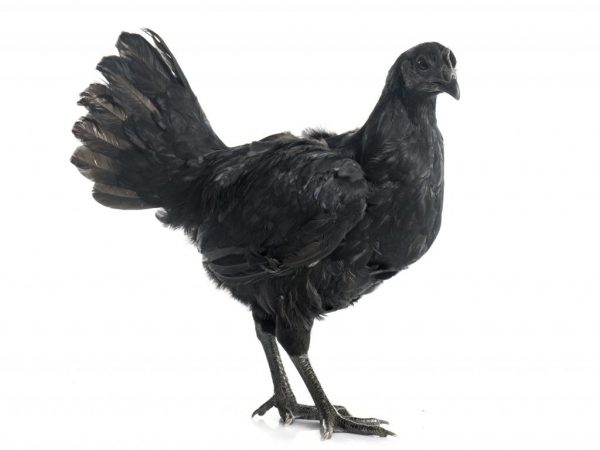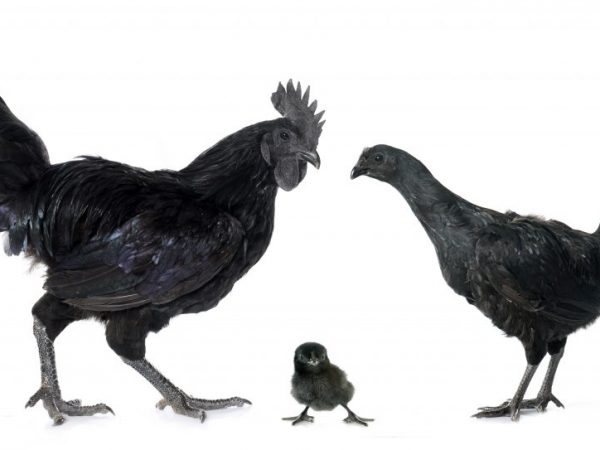The breed of chickens Ayam Tsemani
Many people know the phenomenon of lack of pigmentation, resulting in the appearance of albinos. Ayam Tsemani chickens exhibit the opposite effect, called hyperpigmentation, when the bird is completely black not only on the outside, but also on the inside. Unusual appearance attracted increased attention of exotic lovers to this decorative breed.

The breed of chickens Ayam Tsemani
Indonesia is considered their homeland, the line has several millennia, according to one version, it was obtained by crossing wild and domestic chickens. They say that there are no purebred representatives in the world, the rest of the livestock is already half-breeds. But the dominant gene is so strong that it constantly appears in the next generation.
a brief description of
- Productivity type: decorative.
- Rooster weight: 2 kg.
- Chicken weight: 1.2 - 1.5 kg.
- Ovipositor start: later, after 7-8 months.
- Egg production: low, 100-150 eggs per year.
- Features of the: unpretentious to food, thermophilic, shy.
- Egg size: medium, about 50 g.
- Are they suitable for a beginner: not.
Description of the breed
They called the breed simply "Black Chicken". It differs from ordinary layers in complete monochrome, even the comb, paws and eye circumference do not stand out from the general tone.
The same color remains in the skin, meat, bones, mucous membranes. Farms where this species is grown are located mainly in Germany, Holland, and the Czech Republic. The breed has not received wide recognition in Russia.
The cost
Chickens and young animals are expensive, babies at the age of a week are sold for 700 - 2500 rubles, an adult hen - for 4000 rubles, a rooster is 1 thousand cheaper.
The price of an incubation egg starts from 400 rubles. Survival rate is 100% with extremely high immunity. It is bred as an ornamental breed, meat is prized.
Appearance
The first sign of a breed is color. There should not be the slightest highlighting, much less white spots on the tip of the tongue, metatarsus or chest.
The bird is medium-sized, adult chickens weigh about 1.5 kg, roosters reach 2.
Well-developed legs are considered a distinctive feature; this is a sprinter bird. He runs quickly and with pleasure, so the aviary must be fenced off, the door opens carefully, otherwise some adventure lovers try to slip into it.
The body is shaped like a trapezoid, the chest protrudes forward, the head is small, neat with a short beak and a carved crest of medium size, roosters are proud of a lush tail with clearly distinguishable embossed braids.
Character
Despite the antiquity of the origin of the breed, the birds have not lost their cockiness. In general, they do not like the presence of a person, they get scared, they try to find a secluded place. They do not like touch, they can begin to defend themselves, gradually entering a fighting mood.
It is better not to disturb them too often, but to observe this very interesting bird from afar.
Only roosters sort things out among themselves, the battles are adversarial, after the approval of the supremacy they stop. All individuals are distinguished by increased curiosity and are prone to noisy communication with each other.
Incubation instinct

Chicks hatch for three weeks
Breeding and domestication did not affect the basic instincts, so the hen never abandons the nest, takes care of the chicks, while the survival rate of chickens reaches 95 - 100%. The incubation period is standard, 21 days.
Productivity
A chicken is capable of laying 100 - 160 eggs per year, each weighing about 50 g, has a hard, thick shell of a pinkish hue, the shape is almost round.
The content is no different from the eggs of other breeds, it is not endowed with special properties, the taste is standard.
Advantages and disadvantages
Ayam Tsemani chickens mature for a long time, they begin to rush only by 10 months, the roosters reach sexual maturity after a year. Nevertheless, the breed has many interesting qualities that attract the attention of farm owners.
Positive traits:
- tender black meat;
- exotic appearance;
- excellent care for offspring;
- high immunity;
- excellent hatching and survival rates;
- good adaptation to conditions.
The breed is quite demanding on the frequency of feeding and the composition of the feed, in addition, the owners note that:
- the bird does not tolerate cold weather;
- suffers from a lack of light;
- does not get along with representatives of other breeds;
- low egg production, average egg weight;
- expensive.
Breeding features
The high cost of eggs and young stock does not allow purchasing a large number of poultry immediately. This is not required, since chickens are able to independently breed a new generation, already from the first days getting used to living conditions in a certain region.
Incubation
Chickens sit on the nest on their own, choose dry, elevated places, and treat specially prepared cells favorably.
Since they are very shy, a chicken that has begun hatching in an uncomfortable place can be moved, but only at night and carefully.
The body weight is small, so a standard clutch of 21 eggs may not warm up, it is better to leave it with 17 - 19 eggs.
The hatching period is 3 weeks, after which 2 control days are given and unhatched eggs are removed. The process is going well through the incubator, the conditions are usual, there are no special subtleties for this breed.
Chicks feeding
On the first day, chicks need access to water and close observation, the wet litter is immediately removed.
Babies are fed after 3 hours with small portions of finely ground compound feed. In the first 10 days, the intestines are almost sterile, so no greens are allowed.
You should exclude corn or leave a minimum amount in the feed. Can be fed with low-fat cottage cheese, chopped boiled egg.
Finely chopped greens are gradually introduced. High protein blends are recommended for normal growth and weight gain.
Care

Chickens are afraid of drafts
On the first day, continuous lighting is provided and the temperature is within 30 °.
The Indonesian breed is thermophilic, babies suffer from drafts. On days 2-3, daylight hours alternate with a period of darkness, the temperature gradually decreases.
Further, the conditions of care are generally accepted. The scheme of vaccinations and vitamin supplements must be followed. In liquid form, vitamins are dripped in the right dosage into the beak of each baby.
Automatic drinkers are preferable for water supply, feed and top dressing do not mix.
Features of keeping adults
Chickens are used to warm weather with high levels of humidity. They do not tolerate frosts and piercing autumn winds.
In the heat, continuous access to water is required. To maintain health, you can add vitamins to the morning portion, alternating them with a weak solution of tea or potassium permanganate.
Chicken coop
Basic requirements for the premises:
- protected from drafts;
- has additional heating, ventilation and lighting;
- the area is sufficient, designed to accommodate 5-6 individuals per 1 sq. m .;
- allocated places for nests and incubation chambers;
- closed or semi-closed drinkers;
- the presence of a thick layer of absorbent bedding;
- longitudinal low feeders.
Disinfection is carried out regularly, and the litter is completely removed before it.
Food
They are picky about food; for normal development and the formation of a strong bone base, the diet should contain:
- compound feed;
- mash of vegetables, bagasse, silage;
- vitamins;
- bran.
In the warm season, live food and grass mass are added.
Place for walking
Located on the sunny side, protected from drafts. Artificial asphalt or concrete slabs are unacceptable.
Birds fly well, the height of the fence should be at least 2.5 meters. Sometimes full mesh coverage is required, even on top. Drinking bowls must be placed on the territory, a place for feeding, a sand slide and an ash bath is allocated.
In winter, chickens of the Ayam Tsemani breed are not allowed to walk, they quickly freeze their paws and show symptoms of colds.
Possible diseases
The main problem is the common cold. Chickens that have undergone a full range of vaccinations develop strong immunity to other diseases. During the period of mass diseases of the livestock in neighboring farms, the following may appear:
- infections, including colibacillosis, chicken pox;
- helminthic parasites;
- avitaminosis.
In general, the breed has a high disease resistance. Affects the legacy of wild ancestors, still living in natural conditions on the islands of Indonesia.
Breeders' opinion
According to the owners, from a commercial point of view, raising livestock because of meat and eggs is not profitable, with the exception of the sale of hatching eggs, young stock and adult poultry.
The Ayam Tsemani breed of chickens is used as an unusual decorative one. Not widely used. They note its resistance to disease, caution, instability to cold.


